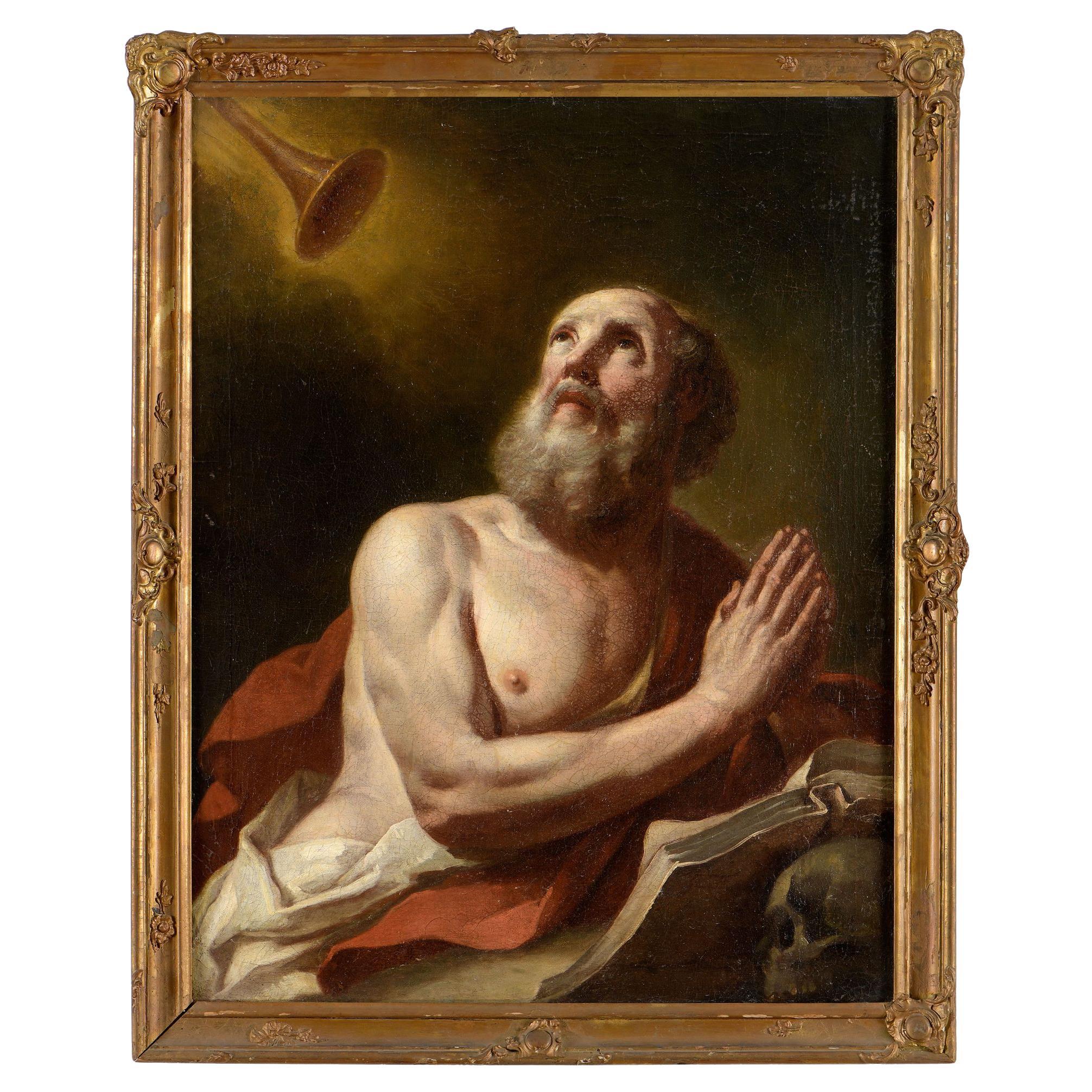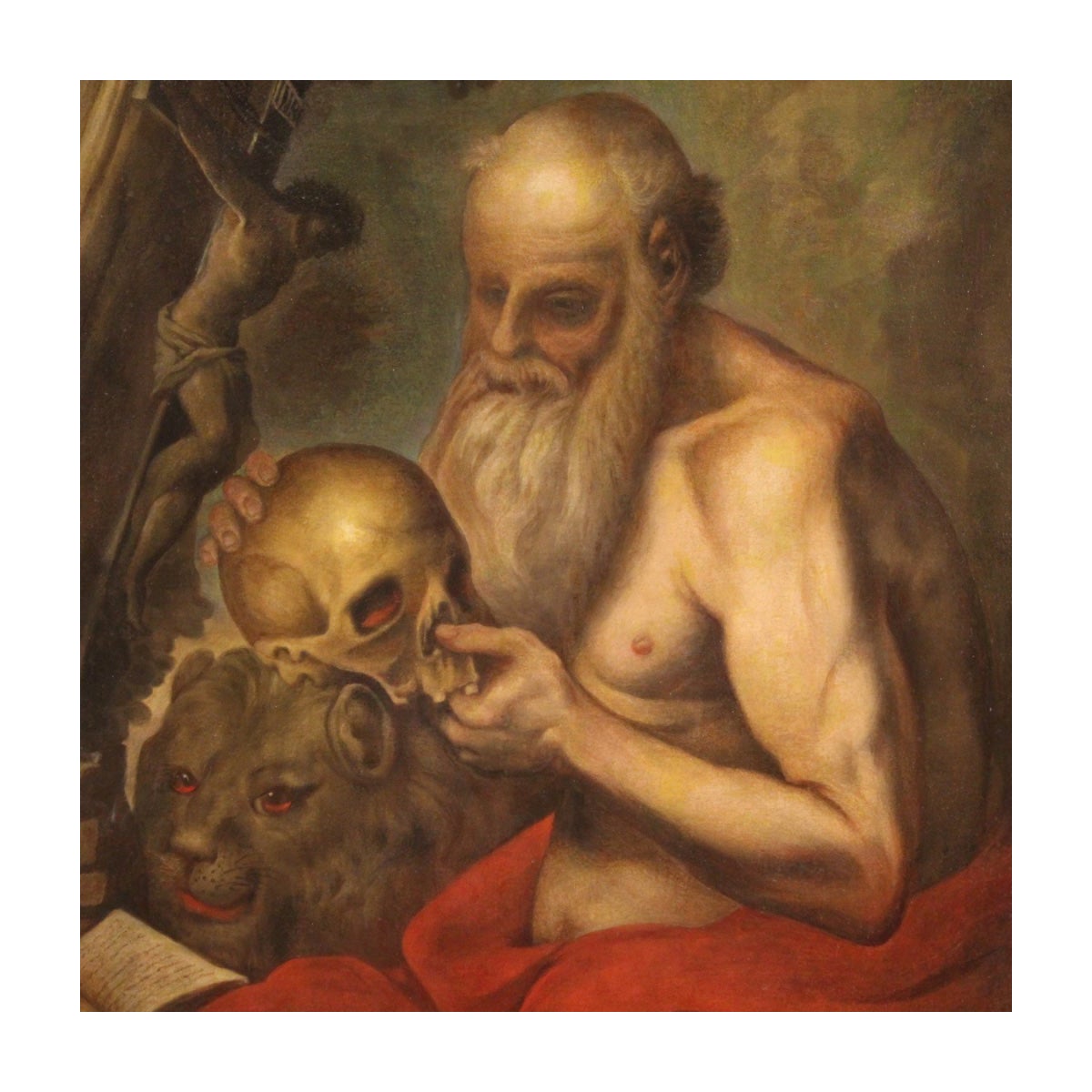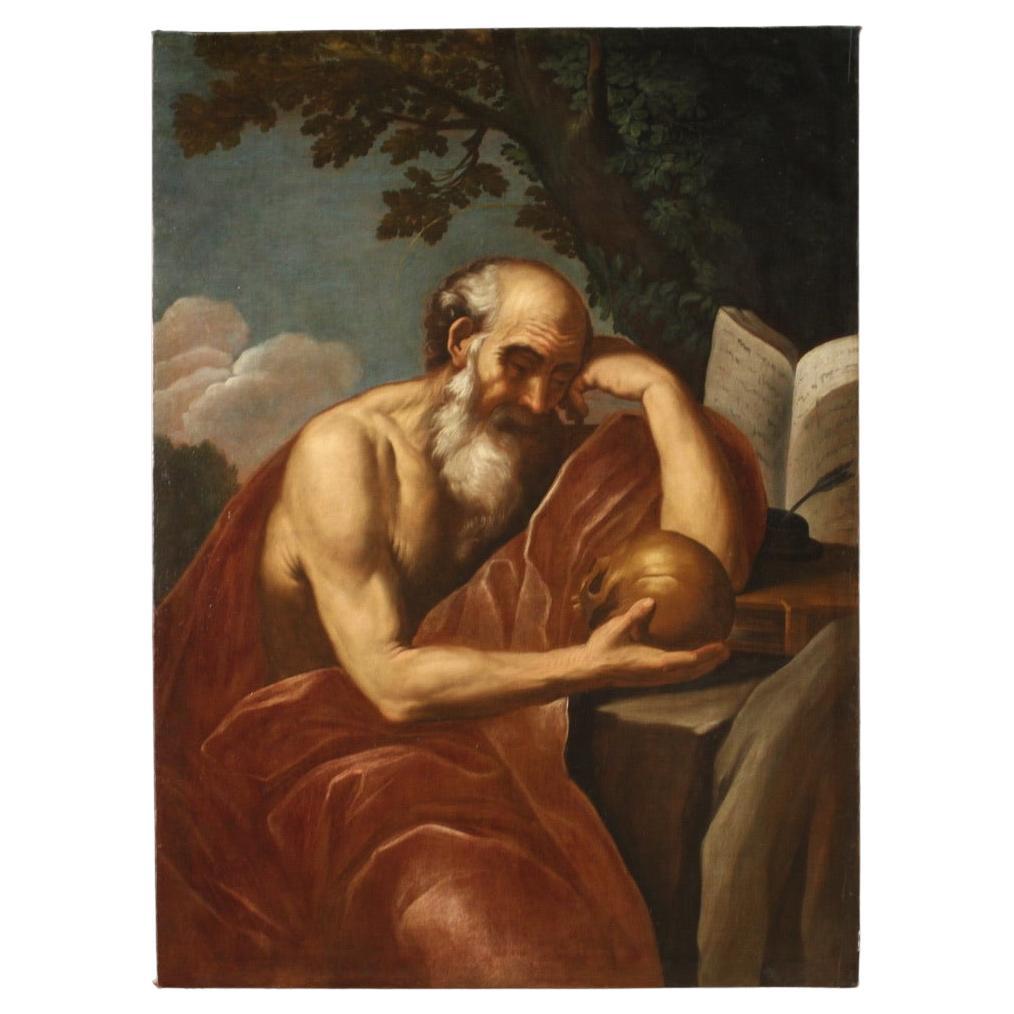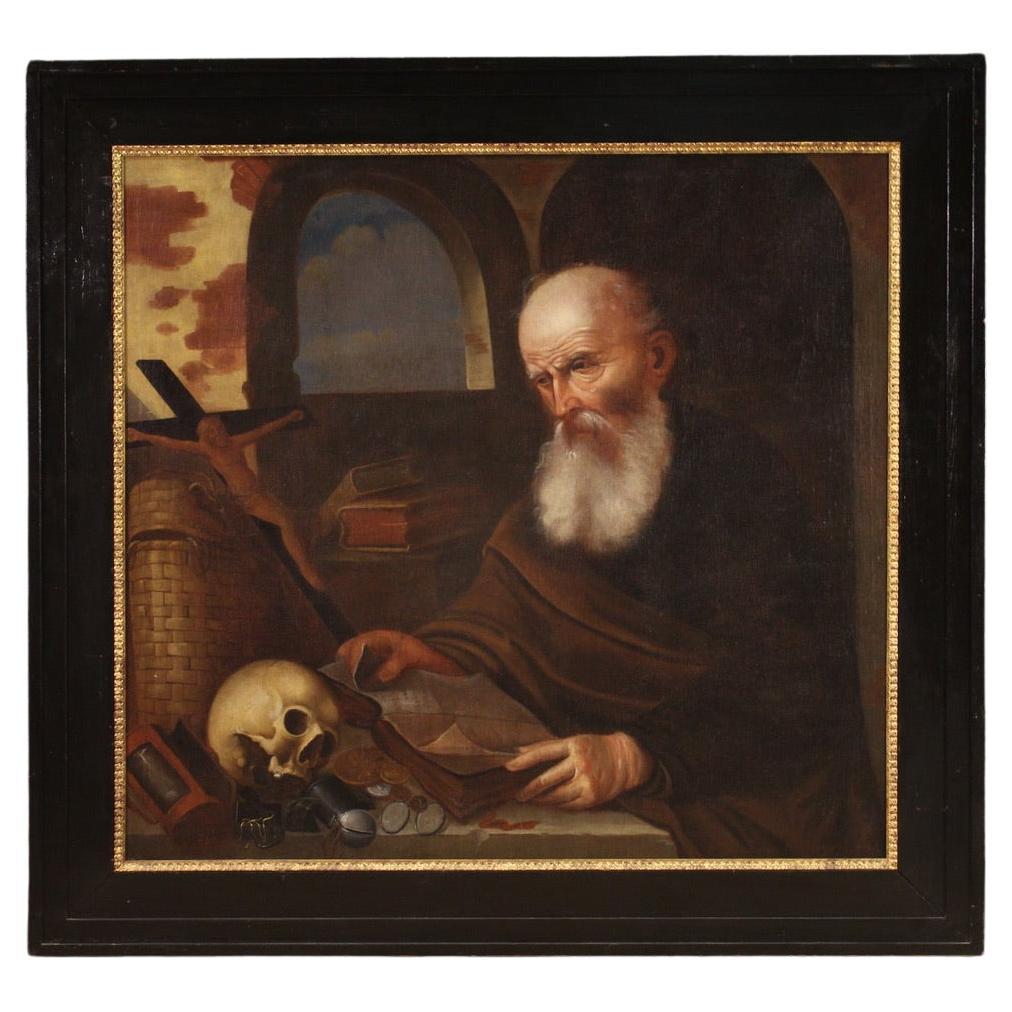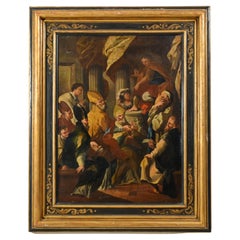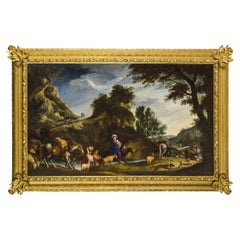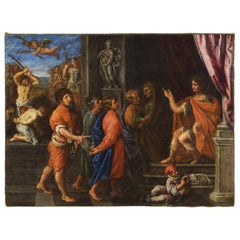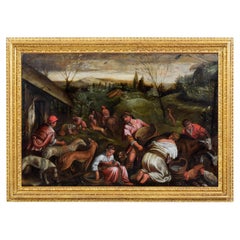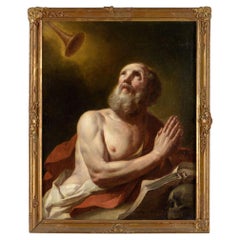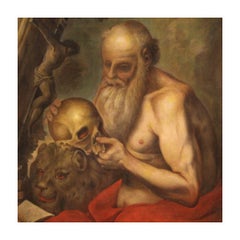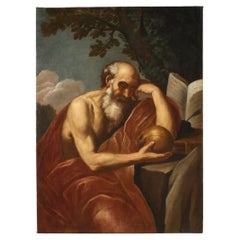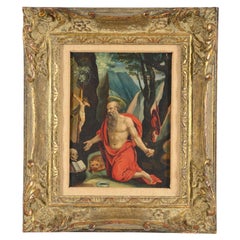Items Similar to 17th Century, Italian Painting Saint Jerome Hears the Trumpet of Judgment
Want more images or videos?
Request additional images or videos from the seller
1 of 14
17th Century, Italian Painting Saint Jerome Hears the Trumpet of Judgment
$19,493.97
£14,611.94
€16,500
CA$26,781.40
A$29,898.91
CHF 15,666.58
MX$365,992.03
NOK 198,965.73
SEK 187,599.42
DKK 125,604.02
About the Item
Saint Jerome Hears the Trumpet of Judgment, Neapolitan School, 17th Century
This exquisite oil-on-canvas painting depicts Saint Jerome hearing the trumpet of the angel of the Last Judgment. The traditional iconography of Saint Jerome is confirmed here through the usual symbols of his meditation: he holds a skull in his right hand, while in the foreground, a book bound in leather is visible. The saint is also typically depicted as a hermit, semi-nude, draped in a red cloak, with gray hair and a long white beard.
Several iconographic representations of Saint Jerome exist, often linked to episodes from his life. One of the most widespread is the depiction of the saint in the desert, either meditating or studying. The book, one of his iconographic attributes, alludes to his numerous exegetical writings and to the Vulgate. The skull symbolizes Vanitas, the transience of human life, and contemplation of death. The red cardinal’s cloak is a recognizable element, originating from a medieval misinterpretation, perpetuated in the Legenda Aurea, which mistakenly considered him a cardinal. Since Jerome served as secretary to Pope Damasus, it was assumed he must have been a cardinal, leading to his depiction in cardinal attire or with elements referring to it, such as the red hat.
The painting under study captures a specific moment in the saint’s life—when Jerome, having retreated into meditation in the desert, recounts hearing the announcement of the Last Judgment, perceiving an angel blowing a trumpet. In the upper right corner, the bell of the angelic musical instrument can be seen, while Jerome is depicted in a twisting motion, raising his left hand upwards. The trumpet with which the angel of the Apocalypse announces the Judgment prompts the saint to reflect on death and his eventual reunion with God.
Saint Jerome, born Sophronius Eusebius Jerome (Stridon, c. 347 – Bethlehem, 420), was declared a Doctor of the Church by Pope Pius V in 1576. He was born in Dalmatia, in present-day Croatia, and was a man of great literary culture. He studied grammar and rhetoric in Rome, where he was baptized. Later, he traveled to Antioch and embraced an ascetic life as a hermit in the desert of Chalcis, south of Aleppo (cf. Ep. 14,10), dedicating himself to biblical exegesis and the study of Greek and Hebrew.
Ordained a priest on the condition that he could maintain his independence as a monk, he began an intense literary career. In 382, he moved to Rome, where he became secretary and advisor to Pope Damasus, who, recognizing his vast erudition and literary expertise, encouraged him to undertake a new Latin translation of the Bible. Drawing from original Greek and Hebrew texts, Jerome translated the four Gospels into Latin, followed by the Psalter and much of the protocanonical texts of the Old Testament. His work became known as the Vulgate, the canonical text of the Latin Church, recognized by the Council of Trent.
After the death of Pope Damasus, Jerome left Rome in 385 and undertook a pilgrimage, first to the Holy Land, then to Egypt, finally settling in Bethlehem in 386, where he remained until his death. He continued his intense work, building monasteries and hospices while promoting classical and Christian education. He is the patron saint of scholars, archaeologists, librarians, students, and translators. The Roman Martyrology commemorates him on September 30.
Stylistically, this painting can be attributed to the Neapolitan school and is the work of a painter active in the 17th century. Historical and artistic studies are currently ongoing.
- Dimensions:Height: 40.56 in (103 cm)Width: 31.5 in (80 cm)Depth: 1.97 in (5 cm)
- Style:Baroque (Of the Period)
- Materials and Techniques:
- Place of Origin:
- Period:
- Date of Manufacture:17th Century
- Condition:Wear consistent with age and use.
- Seller Location:IT
- Reference Number:1stDibs: LU4405244360612
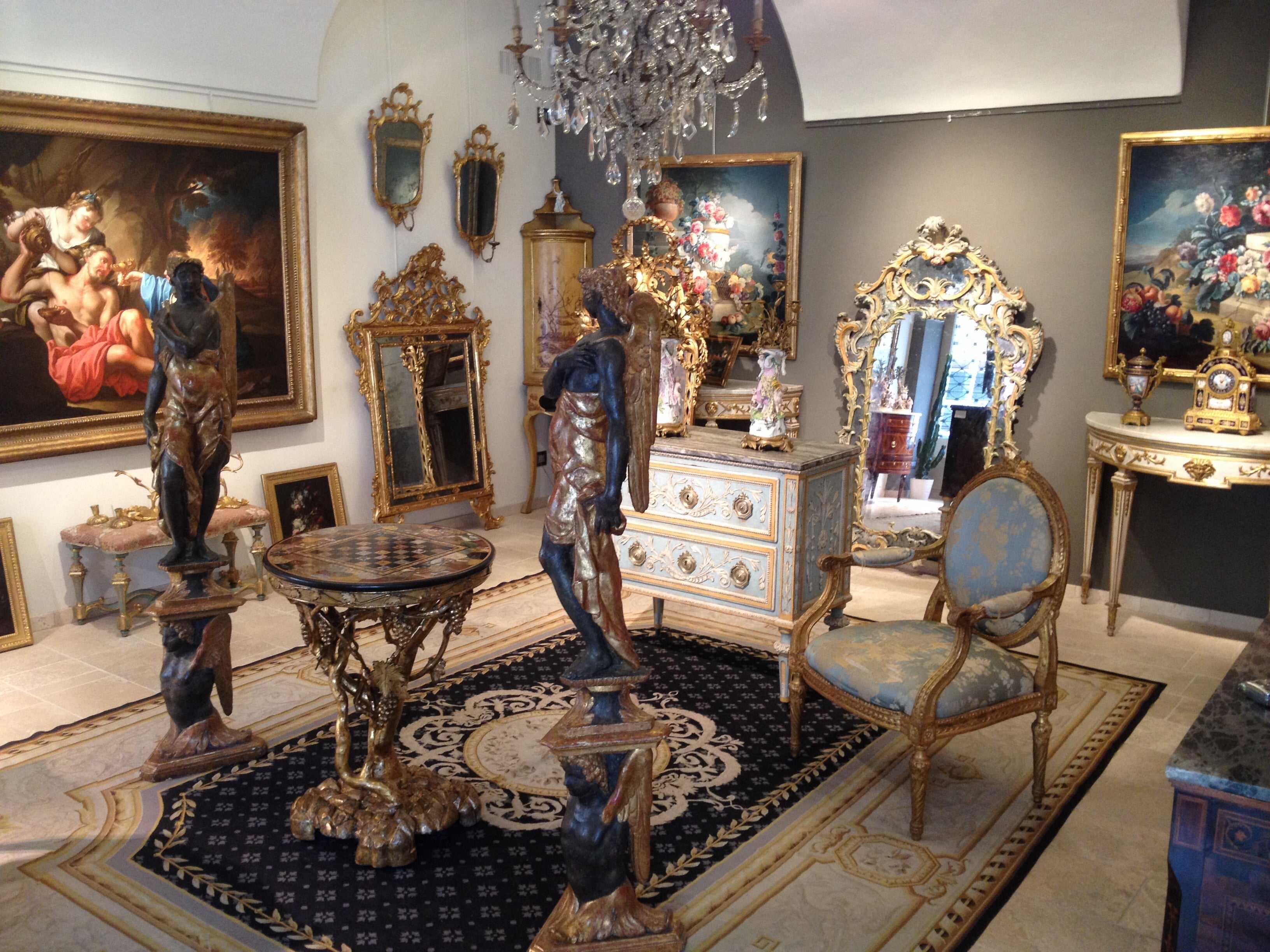
About the Seller
5.0
Platinum Seller
Premium sellers with a 4.7+ rating and 24-hour response times
Established in 1980
1stDibs seller since 2019
56 sales on 1stDibs
Typical response time: 1 hour
- ShippingRetrieving quote...Shipping from: Italy
- Return Policy
Authenticity Guarantee
In the unlikely event there’s an issue with an item’s authenticity, contact us within 1 year for a full refund. DetailsMoney-Back Guarantee
If your item is not as described, is damaged in transit, or does not arrive, contact us within 7 days for a full refund. Details24-Hour Cancellation
You have a 24-hour grace period in which to reconsider your purchase, with no questions asked.Vetted Professional Sellers
Our world-class sellers must adhere to strict standards for service and quality, maintaining the integrity of our listings.Price-Match Guarantee
If you find that a seller listed the same item for a lower price elsewhere, we’ll match it.Trusted Global Delivery
Our best-in-class carrier network provides specialized shipping options worldwide, including custom delivery.More From This Seller
View All18th Century, Italian painting with Saint Nicholas and the miracle of the brick
Located in IT
18th Century, Italian painting with Saint Nicholas and the miracle of the brick
Oil on canvas; Frame cm H 136 x W 109 x D 10. Canvas cm H 100 x W 74
The oil on canvas painting, with...
Category
Antique 18th Century Italian Baroque Paintings
Materials
Canvas
17th Century, Italian Painting by Pier Francesco Cittadini, Jacob and his Family
Located in IT
Pier Francesco Cittadini (Milan, 1616-Bologna, 1681)
"Jacob and his family go to Egypt"
Oil on canvas, cm 109 x 190 (canvas only)
The valuable painting, made in oil on canvas, depicts Jacob and his family go to Egypt and we believe it can be, given the high quality painting, autograph work of Italian Pier Francesco Cittadini (Italy Milan, 1616 - Bologna, 1681) made after 1647. The work, in excellent condition is accompanied by a coeval frame in wood finely carved and golden.
The scene depicted, which was confused with the Flight to Egypt in the past years, is instead identified with the biblical episode of Jacob’s journey. In the foreground, reading the painting from left to right, we see a caravan composed of animals, including donkeys, dromedaries, goats, dogs and horses and people, women, men and slaves, who carry on their journey along the banks of a river, following a path that to the right, would seem to lead to the through of a bridge. In addition to the watercourse is described an environment characterized by large rocks and impervious come far to cover the entire verticality of the canvas. On the left, in the distance, we see the tail of the caravan that runs along the steep path. Large trees enliven and harmonize the environment, as well as white and grey clouds characterize the predominantly clear sky and illuminated on the right by sunlight.
The story is told in the Bible, Book of Genesis, 30, 25, passage in which is described the flight of Jacob from Haran after the contrasts with Laban, father of his wife Rachel. Jacob is the third great patriarch of the Bible. From his descendants originate the twelve generations of the people of Israel. He is the son of Isaac and Rebekah, who led him to flee from the wrath of Esau to Haran to seek refuge from his brother, Laban. At his uncle’s house Jacob met his daughter Rachel. As soon as he saw his cousin, Jacob was taken. Jacob will stay seven years in the service of Laban to marry his beloved Rachel. But Laban, with a deception, will give him in marriage first Lia, the least beautiful eldest daughter, and only after another seven years the splendid Rachel. From his first wife he will have several children, while Rachel will give birth to the beloved son, Joseph, who will become viceroy of Egypt.
After years of service, Jacob asked to be paid with every dark-coloured garment among the sheep and every spotted and dotted garment among the goats. Laban accepted and sent away from his sons all the leaders of that kind. So Jacob took fresh branches of poplar, almond and plane tree, and flayed them, and put them in the troughs. The optical suggestion induced the goats and the sheep to conceive and give birth to dark, striped and dotted garments. He also ensured that all the strongest and healthiest leaders of the flock of Laban would drink near the barked branches, thus assuring a genetic superiority to his part of the flock. His flocks grew numerous and strong and he became richer than his relative, arousing envy. It was clear that Laban would not respect him much longer. At the suggestion of the Lord, Jacob decided to return to Canaan. Trying to avoid any possible dispute, he left with his family while Laban was absent for shearing sheep. But when, three days later, his uncle returned home, he became angry, feeling offended because Jacob had gone secretly and had not allowed him to greet his daughters and grandchildren. In addition, his teraphim, statuettes, or idols, which depicted the family deities, had disappeared. After 7 days of pursuit, Laban and his men reached Jacob’s group on Mount Gilead, in the mountainous region west of the Euphrates River, where his uncle and grandson had a stormy conversation. The younger man was outraged at being accused of stealing idols and told Labano to rummage through his family’s tents at will. Neither of them could know or even imagine that it was Rachel who took the idols and hid them in the saddle of the camel. During the search, she sat down firmly on the saddle, apologizing for not being able to get up, «because I usually have what happens to women» (Gen 31:35). So the loot wasn’t discovered.
The author of this work was inspired by the composition of an engraving by Stefano Della Bella (1610-1664) of circa 1647. The engraving by Stefano della Bella bears the title "Iacob sur ses vieux jours quitte sans fascherie pour voir son filz Ioseph, sa terre et sa patrie" and is signed on the bottom left "Stef. of the Beautiful In. et fe." while on the right it is declared "Cum privil. Regis", that is with license of the king.
Stefano Della Bella (Italy - Florence, May 18, 1610-Florence, July 12, 1664) was born in a family of painters, sculptors and goldsmiths and was left early orphan of his father sculptor, he dedicated himself first to the art of goldsmith at the school of Giovanni Benedetto Castiglione and Gasparo Mola, then turning his attention to drawing and engraving. He soon began drawing figures and copying the etchings of Jacques Callot, which inspired his early works. Under the protection of the Medici, in particular of Don Lorenzo, cadet son of Grand Duke Ferdinand I, Della Bella has the opportunity to make study trips to Rome, where he stayed from 1633-1636; In Rome he met French engravers and publishers of prints such as Israël Henriet and François Langlois, who influenced his decision to move to Paris in 1639, four years after the death of Callot. In Paris he soon reached, thanks to the engravings commissioned by Cardinal Richelieu, the success also worldly; he frequented courtiers, theatre artists and writers, while refusing too oppressive honors. In 1646-1647 he continued his travels in the Netherlands to Amsterdam, Antwerp and Dordrecht. He returned to Florence in 1650 and resumed working under the protection of the Medici court, working for his patrons. In 1656 he became a member of the Academy of Apatists.
The painting object of this study is reasonably attributable to Pier Francesco Cittadini, or Pierfrancesco Cittadini, called the Milanese or the Franceschino (Italy - Milan, 1616-Bologna, 1681) as some exemplary stylistic comparisons proposed to follow can prove.
Pier Francesco Cittadini was an Italian baroque painter, mainly active in Bologna.
His artistic training first took place with the painter Daniele Crespi...
Category
Antique Mid-17th Century European Baroque Paintings
Materials
Canvas, Giltwood
17th Century, The Martyrdom of the Four Crowned Saints by Giuliano Dinarelli
By Carlo Piacenza
Located in IT
17th century, The condemnation and martyrdom of the four crowned saints by Giuliano Dinarelli
Mid-17th century, Italy, Bologna
Oil on canvas, frame ...
Category
Antique Mid-17th Century Italian Baroque Paintings
Materials
Canvas
17th Century, Italian painting Allegory of the Spring Follower of Jacopo Bassano
By Jacopo Bassano
Located in IT
Follower of Jacopo Da Ponte, called Jacopo Bassano (Bassano del Grappa, circa 1510 - Bassano del Grappa, 13 February 1592), 17th century
Allegory of the Spring
Measures: With frame: ...
Category
Antique Late 17th Century Italian Baroque Paintings
Materials
Canvas
18th Cent., Italian Painting, Loth and the daughters, att. to Giuseppe Gambarini
By Giuseppe Gambarini
Located in IT
Giuseppe Gambarini (Bologna, 17 March 1680 - Casalecchio di Reno, 11 September 1725)
Loth and the daughters
Oil on canvas; Measurements: cm H 73 x W 93; frame H 88 x W 108 x D 5,5
The painting, of beautiful pictorial quality, depicts the biblical scene of Lot and his daughters, with Sodom set on fire in the background, and is stylistically attributable to the italian painter Giuseppe Gambarini (Italy, Bologna, 17 March 1680 - Casalecchio di Reno, 11 September 1725).
The canvas shows in the center Lot sitting and already drunk, depicted according to traditional iconography, old, gray and with long gray boat. With his left hand he grabs the wine flask that one of his daughters offers him. She is depicted kneeling and resting on large boulders of stone, described as an architectural base, dressed in a voluminous deep blue mantle, her hair covered with a humble headdress made of a knotted cloth; look at the viewer, as if to want to involve him directly in the scene. The other daughter is described on the left, from the back to the observer, with a bare back and dark hair gathered by a red ribbon. She too is intent on serving her father a cup in which to pour the wine. Around them a duck placed on a cloth, some bread and another wine flask enrich the composition describing a banquet in progress. The scene is set outdoors, where only a large tent supported by branches arranged in a hut serves as a shelter to the figures. In the background a forest landscape blends chromatically with the blue sky. To the right in the distance, is described the city of Sodom, already destroyed and on fire. Lot’s wife...
Category
Antique Early 18th Century Italian Baroque Paintings
Materials
Canvas
$21,738 Sale Price
20% Off
18th Century, Italian painting with Sacred Heart of the Child Jesus by Pietro Ba
By Pietro Bardellino
Located in IT
Pietro Bardellino (Italy - Naples, 1732 - 1806), attr., Sacred Heart of the Child Jesus
Measurements: with frame, cm L 86 x H 99 x P 8; only the canvas, cm L 78 x H 64
The painting, made in oil on canvas, represents the Sacred Heart of the Child Jesus. Stylistically the work is attributable to Pietro Bardellino (Italy, Naples, 1732 - Naples, 1806), a pupil of Francesco De Mura and considered by critics one of the most gifted and sensitive exponents of the Rococo style in Naples.
The canvas represents the Child Jesus, surrounded by flowers in an outdoor setting, while showing the sacred heart. The canvas has a well-balanced color and a strong sweetness of the child’s traits, which with the complicit gesture of the right hand, involves the viewer in the intimate and delicate sharing of the garden in which he sits. The roses, in addition to being a beautiful piece of still life, contribute to enrich the Christological message, being bearers of symbolic meanings. Marian attributes par excellence, are often side by side with Christ, whose thorns foreshadow the Passion. In the canvas, on the top left, two cherubim are observed: among them, according to the Old Testament, is God: the author therefore puts into place an iconographic and iconological hyperbole that amplifies its meaning. The iconographic theme of the Child Jesus with the Sacred Heart in his hand spread between the second half of the eighteenth century and the first of the following century. With the worship of the Sacred Heart of Jesus, the Catholic Church intends to honour the Heart of Jesus Christ, one of the organs symbolizing his humanity, which by intimate union with the Divinity, has the right to worship and love of the Saviour for men, of which His Heart is the symbol. It represents one of the fundamental devotions of Christian life, as it manifests the true face of God, who is prodigal and boundless love. It was the French mystic Saint Margaret Mary Alacoque...
Category
Antique Mid-18th Century Italian Baroque Paintings
Materials
Canvas
You May Also Like
Amazing Flemish Master 17th Century "Saint Jerome"
By Europa
Located in Madrid, ES
Amazing Flemish Master 17th Century "Saint Jerome"
Oil/canvas/double,
82 x 64 cm.
good condition
Category
Antique Early 17th Century Dutch Baroque Paintings
Materials
Paint
17th Century Oil on Canvas Italian Antique Religious Painting Saint Jerome, 1670
Located in Vicoforte, Piedmont
Antique Italian painting from the late 17th century. Oil on canvas artwork depicting a religious subject, Saint Jerome, of good pictorial quality. A painting of good size and great i...
Category
Antique 1670s Italian Paintings
Materials
Canvas
17th Century Oil on Canvas Italian Religious Painting Saint Jerome in Meditation
Located in Vicoforte, Piedmont
Italian painting from the second half of the 17th century. The painting, oil on canvas, is an interesting ancient replica of a very famous composition by Guido Reni depicting Saint J...
Category
Antique 1670s Italian Paintings
Materials
Canvas
$18,903
Free Shipping
17th/18th century Flemish old master oil painting of Saint Jerome
Located in Long Island City, NY
17th/18th century Flemish old master painting of Saint Jerome in a landscape with objects. Oil on copper. Framed. Light inscription on reverse. Sight: 9 x 7in. Overall: 14 x 12in.
Co...
Category
Antique 17th Century Unknown Paintings
Materials
Copper
$3,250 Sale Price
50% Off
17th century oil on copper portrait - St. Jerome
Located in Braintree, GB
In this antique 17th-century oil painting on copper, we see St. Jerome, encased within an intricately adorned wooden frame. Jerome assumes the role of a penitent, deeply engrossed in...
Category
Antique 17th Century European Paintings
Materials
Copper
17th Century Oil on Canvas Flemish Religious Painting Saint Jerome in his Study
Located in Vicoforte, Piedmont
Flemish painting from the first half of the 17th century. Oil on canvas artwork depicting a religious subject of great charm, Saint Jerome in his study. He lived between the fourth a...
Category
Antique 1630s Dutch Paintings
Materials
Canvas
More Ways To Browse
Baroque Secretary
Italian Painted Secretary
Baroque Trumpet
Meditation Bell
17th Century Secretary
Italian Baroque Secretary
Neapolitan Angel
Monks Settle
Vintage 18 Wheelers
Vintage German Teapots
Vintage Green Glass Footed Bowl
Vintage Skates
Vintage Stone Crusher
Vintage Stone Shoes
Windsor Dining Table
16th Century Bed
800 Silver Tea Set
Abercrombie Leather
